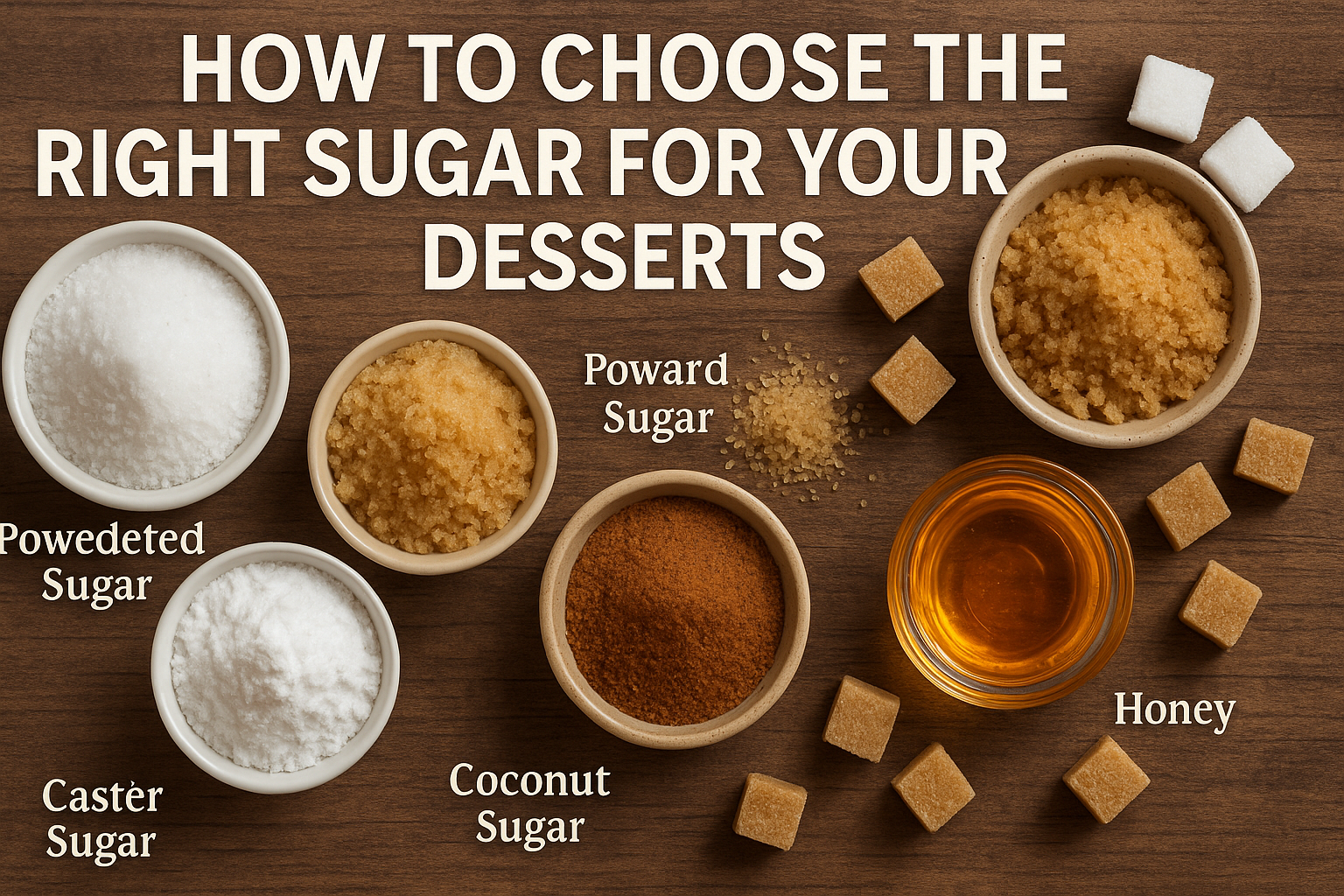Sugar does more than just sweeten. It affects texture, moisture, color, and structure in nearly every dessert recipe. But with so many types of sugar available — white, brown, powdered, raw, and more — how do you know which one to use?
In this guide, we’ll break down the most common types of sugar, when to use each, and how they can change your desserts.
Why Sugar Type Matters
Using the wrong kind of sugar can lead to:
- Flat cookies
- Dense cakes
- Gritty texture
- Unexpected flavor or color
- Lack of structure in candies or frostings
Understanding sugar types helps you follow recipes better, or even tweak them for improved results.
1. Granulated White Sugar
Description:
- Fine, dry white crystals
- The most common sugar in baking
Best For:
- Cakes, cookies, muffins, pies
- Caramelizing
- Meringue, whipped cream, frostings
How It Affects Desserts:
- Creates light, airy texture in batters
- Helps baked goods rise
- Melts evenly for caramel or syrups
- Doesn’t add flavor beyond sweetness
✅ When a recipe calls for just “sugar,” it usually means granulated white sugar.
2. Brown Sugar (Light and Dark)
Description:
- White sugar with molasses added
- Moist, clumpy texture
- Dark brown sugar = more molasses and stronger flavor
Best For:
- Cookies (chewy texture)
- Caramel sauces and puddings
- Banana bread, spice cakes, cinnamon rolls
Flavor:
- Warm, rich, slightly caramel-like due to the molasses
Tip:
- Pack it tightly in measuring cups
- Store in airtight containers to prevent hardening
✅ Use dark brown for deeper flavor, light brown for milder sweetness.
3. Powdered Sugar (Confectioners’ Sugar)
Description:
- White sugar ground into a fine powder
- Usually mixed with cornstarch to prevent clumping
Best For:
- Glazes and frostings
- Whipped cream
- Dusting cakes, cookies, or tarts
- No-bake desserts
Texture:
- Dissolves quickly
- Creates smooth, velvety finishes
❄️ Perfect for creamy buttercream frosting or royal icing.
4. Raw Sugar (Turbinado, Demerara)
Description:
- Coarse, golden crystals
- Minimal processing, retains some molasses
Best For:
- Sprinkling on top of baked goods (adds crunch)
- Sweetening drinks
- Rustic fruit crisps and pies
Texture:
- Doesn’t dissolve easily in batter
- Crunchy and sparkly when baked on top
✅ Adds texture and a subtle caramel flavor when used as a topping.
5. Caster Sugar (Superfine Sugar)
Description:
- Finer than granulated sugar, but not powdered
- More common in UK/Australia recipes
Best For:
- Meringue, whipped cream, sponge cakes
- Cold drinks (dissolves faster)
- Delicate desserts
🔄 Can be made at home: pulse granulated sugar in a blender for a few seconds.
6. Coconut Sugar
Description:
- Made from the sap of coconut palm
- Brown in color, with a caramel-like flavor
Best For:
- Healthier dessert options
- Recipes with chocolate or spices
- Cookies, granola bars, muffins
Notes:
- Lower glycemic index
- Doesn’t dissolve as easily as white sugar
- May cause darker color in baked goods
🥥 Great in vegan or alternative baking.
7. Liquid Sugars (Honey, Maple Syrup, Agave)
Description:
- Naturally sweet syrups
- Used for moisture and unique flavor
Best For:
- No-bake desserts
- Marinades and sauces
- Cakes and muffins (when adjusted correctly)
Tips:
- Reduce other liquids in the recipe
- Use ⅔ cup liquid sweetener for every 1 cup of granulated sugar
- Add ¼ tsp baking soda to balance acidity if needed
🍯 Each liquid sweetener brings its own flavor — experiment to find your favorite.
Sugar Substitutes (Briefly)
While not sugars, some people bake with substitutes like:
- Stevia
- Erythritol
- Monk fruit
- Xylitol
These often behave differently in baking, affecting browning, texture, and moisture. Use only in recipes designed for them or follow brand-specific substitution ratios.
Final Tips for Using Sugar in Desserts
- Creaming butter with sugar incorporates air — use granulated for this step
- Always sift powdered sugar for smooth glazes
- Store brown sugar with a piece of bread or apple slice to keep it soft
- Don’t substitute blindly — sugar affects structure and chemistry, not just taste
Final Thought: Sweet Decisions Matter
Choosing the right sugar might seem like a small detail, but it has a big impact on how your desserts turn out. From the crisp edges of cookies to the smooth glaze on a cake, the sugar you use plays a starring role.
So next time you’re in the kitchen, check your sugar — and pick the one that’s just right for your creation.

